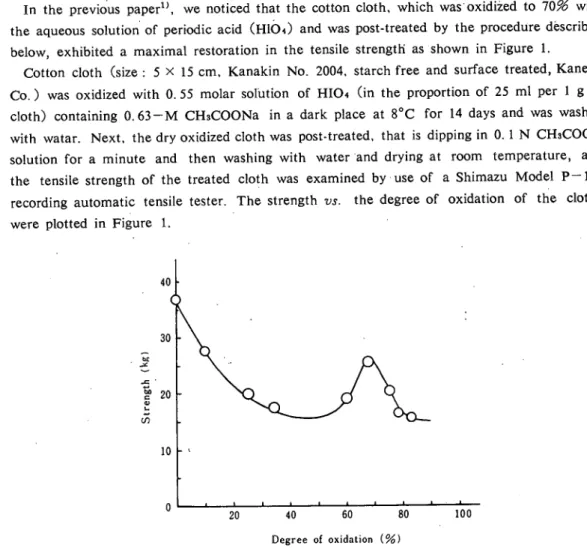A Consideration with the Restoration in the Strength
ofthe Cotton Cloth Oxidized with Periodic Acid
Toyomichi NiSHIUCHI and Shinichi Segawa Laboratory of Organic Chemistり、Faculty 0/ Education
In the previous paperl’、we noticed that the cotton cloth、 which was oxidized t0 70%with\ the aqueous solution of periodic acid (H104)and was post-treated by the procedure described below、exhibited a maximal restoration in the tensile strength as Ishown in Figure 1 。 Cotton cloth (size : 5 ×15 Cm、Kanakin N0. 2004、starch free and surface treated、 Kanebo Co.) was oxidized with 0.55 molar solution of HIO4 (in the proportion of 25 ml per l g of
cloth) containing 0.63-M CHsCOONa in a dark place at 8°C for 14 days and was washed
with watar. Next、the dry oxidized cloth was post・treated、 that is dipping in 0. 1N CHaCOOH solution for a minute and then washing with water ‘and drying at room temperature、and the tensile strength of the treated cloth was examined by ’use of a Shimazu Model P− 100 recording automatic tensile tester. The strength フjs. the degree of oxidation of the cloth were plotted in Figure 1.
こ2︶mSuajjg
0
2 0 4 0 6 0 8 0 1 0 0
Degreeof oxidation(%)
Figure 1. Ralation between degree of oxidation and strength of the dry cloth post・treated with 0.IN CHsCOOH solution
Cellulose of the cloth changes to dialdehyde cellulose (DAC)by the reaction with HI04 solution、but the cloth varied rarely in appearance.
The restoration in the strength of the oxidized cloth may be considered to result from intermolecular acetal-linkages of CHO-groups with OH-groups in DAC molecule by the
post-treatment described above.
It is considered、therefore、that a maximum of restoration in the strength correspond to a maximum of the intermolecular acetal・linkage、 that is the maximum of the combinations of
62 Res. Kochi Univ. Vol. Nat. Sci. No. 10
CHO・ and OH-groups which are able to combine each other.・ However、it can be assumed
that one CHO-group of each dialdehyde group in all oxidized glucose units of DAC does not take part in the aceta!-linkage since the sufficient OH・groups・ are not present in the vicinity of the dialdehyde group。
Now、the number of CHO・group per 100 glucose units is 2n and that of OH-group is
(300−2n)、where n(%)iS the degreeof oxidation of the oxidized cloth. Since CHO-group
reacts with 2 0H・groups to form an acetal-linkage、 accordingly it is n=150-n、hence n=75 96. Consequentlyにit is probable that the 75 96 oxidized cloth shows a maximum restoration of thとstrength. According to・the experimental results、the restoration showed a maximum in the cloth which was oxidized t0 70 96. This result agrees approximatly with the calculated
value described above. It is considered that the gap between the calculated and the
ex-perimental value results from the neglect of chemical structure of・ the end groups in DAC or from the depolymerization of cellulose molecule accompanying the oxidation of the cloth with HIO4 solution. Furthermore・ from the result that the highest restoration ratio in the strength is ca. 70 96 against that of the original cloth、it is understandable that the drop in the strength of the cloth which is caused by the ring-opening of the glucose unit of the cellulose owing to HIO4-oxidation is relatively great and the binding energy of the intermolecular acetal-linkage in the cloth is relatively small. =・ 、、
REFERENCE
1) T. Nishiuchi and S. Segawa. Res. Rep. Kochi Univ. (Nat. Sci.), 22, 237 (1973).
